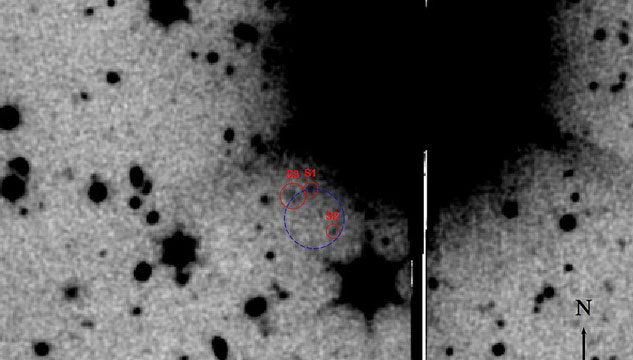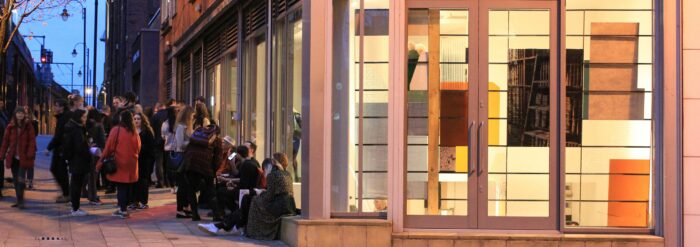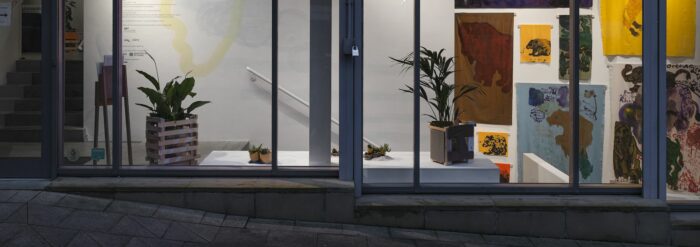
Artists and Scientists
Artists and Scientists
29 May 2018
18:30-20:30
A Castlefield Gallery Associates event
Our May CG Associates session takes a look, from both sides of the lab bench, at artist/scientist co-operation. Jon Biddulph and Dave Griffiths will talk about their experience of working with astronomers, forensic archaeologists, microbiologists and nuclear scientists, while botanist Alicia Prowse and microbiologist Jo Verran will provide a scientist’s perspective on working with artists. This session is especially aimed at artists wanting to know how to go about working with scientists. The topic was nominated by CG Associate Sam Meech in response to a Member’s Choice callout.
Jon Biddulph is a Manchester-based artist, educator, garden designer and sourdough bread baker. Until 2003, as a founder-member of TEA (with Val Murray, Peter Hatton and Lynn Pilling), he explored the idea of people and place in multiple media. More recently he has created ‘place’ through gardens – in themselves complex mixes of design, botany, geography and sociology. His current fascination with microbiology, and more specifically the Human Microbiome – the complex and essential ecosystem of microbes living on and in the body – explores the integration of person and ‘place’ as a living, walking ecosystem.
His work Microbe Me is an outcome of on-going experiments in Manchester Metropolitan University Microbiology Labs to create and record cultured self-portraits using microbes from the artist’s face mapped onto agar plates overlaying a photographic portrait of the artist.
www.art.mmu.ac.uk/profile/jbiddulph
Dave Griffiths explores photographic images as lenses through which we commemorate and navigate history. He combines image fragments and acts of durational seeing, in hybrid assemblages of film, animation, sound, print and data. His compressed narrative maps consider media artefacts as observatories for locating our being in deep time and space.
Currently Dave is using the material and historical potential of analogue microfilm to depict transition, chaos and extinction. As an archival media durable for 500 years, microfilm can be understood as a mythological solution to digital insecurity. He has worked with forensic archaeologists in response to new evidence of execution sites at Treblinka, and with astronomers observing deep-field gamma-ray bursts. Through participation with art and science communities, Dave Griffiths encourages us to speculate about the future survival and reception of images, and what it means to transmit and translate contemporary information through deep time.
http://www.davegriffiths.info/blog/
Alicia Prowse started out as a biologist, gaining a Phd in Plant Ecology in 2001 looking at the ecological impact of an invasive ‘alien’ species (Himalayan balsam) on native plant communities. She subsequently worked with artist Kerry Morrison with whom she has collaborated for the last seventeen years. Commissions include work with the Wellcome Trust and NESTA, Liverpool Biennial and the Art Institute of Chicago. This was alongside working as a university lecturer, although she has also worked as woodland surveyor, professional actor and teacher of English to speakers of other languages. Alicia has taught Ecology and Biology to BSc Biology students; Research Methods for biologists to social science students; and Environmental Science and Biology to Further Education students. She currently works in the Centre for Excellence in Learning and Teaching at Manchester Metropolitan University. Research interests are interdisciplinary collaboration, student motivation and academic staff development. She is a Principal Fellowship of the UK Higher Education Academy.
https://www.celt.mmu.ac.uk/about_celt/staff_details.php?id=11
Jo Verran is Emeritus Professor of Microbiology at Manchester Metropolitan University and recently retired as Head of the School of Research, Enterprise and Innovation and Head of Science Communication and Public Engagement in the Faculty of Science and Engineering. She has researched the interactions of microorganisms with surfaces such as food preparation surfaces, water pipes and dentures and worked with surface engineers and other microbiologists to make and characterise novel surfaces, and then observe their effect on the viability, attachment and removal of microorganisms.
Jo has always encouraged her science students to consider art as a route for communicating science, and to use their creative skills to produce a variety of outputs. She has collaborated with artists on a range of sci-art projects, such as the AIDS Community Quilt with Lynn Setterington and seeking an unacceptable profile with David Haley as well as providing scientific advice to a range of artists, and providing laboratory advice, access and training for artists in the microbiology lab.
Jo has developed a range of innovative and ingenious activities to encourage discussion around key issues such as disease transmission (using vampires and zombies!), vaccination (using computer games), infectious disease (the Bad Bugs Bookclub, which discusses novels where infectious disease forms part of the plot), food production and antimicrobial resistance. She is currently working with textile technologist Jane Wood on the use of “vegetable leather”.
http://www2.mmu.ac.uk/shs/staff/profile/index.php?id=1986
£6.95 / FREE for CG Associates. Book at Eventbrite
Find out more about CG Associates HERE
Image: Dave Griffiths – Extinction Event (2013)

